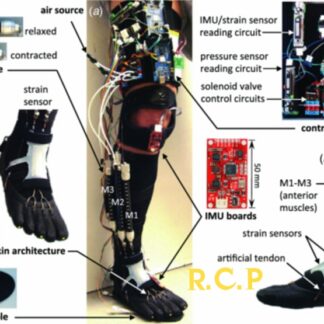Description
Designed by our High Tech Team At Radio Control Products (RCP) includes linux base compatible software
Advanced soldier exoskeletons are still in their early stages of development, but they hold immense potential to revolutionize the battlefield of the future. Imagine soldiers equipped with suits that enhance their strength, endurance, and agility, allowing them to carry heavier loads, move faster and farther, and even protect them from harm. Here’s a glimpse into the exciting world of these cutting-edge advancements:
Types of Exoskeletons:
-
- Passive Exoskeletons: These lightweight, non-powered suits provide support and assistance through mechanical linkages and springs, reducing fatigue and strain on the soldier’s body. They’re ideal for tasks like carrying heavy backpacks or crouching for extended periods.
-
- Powered Exoskeletons: These incorporate motors and actuators to amplify the soldier’s strength and movement. They can significantly increase lifting capacity, enable superhuman jumps and sprints, and even offer limited armor protection. However, they’re typically bulkier and require a source of power, like batteries.
Key Features:
-
- Enhanced Strength and Endurance: Exoskeletons can help soldiers carry heavier loads, march farther, and perform physically demanding tasks with less fatigue. This translates to increased operational range, improved performance, and potentially reduced injuries.
-
- Augmented Agility and Speed: Powered exoskeletons can boost soldiers’ running speed, jumping height, and overall maneuverability. This can be crucial for evading enemy fire, navigating difficult terrain, and engaging in close-quarters combat.
-
- Improved Situational Awareness: Some exoskeleton concepts integrate advanced sensors and displays, providing soldiers with real-time information about their surroundings, enemy positions, and environmental hazards. This can enhance tactical decision-making and improve battlefield awareness.
-
- Enhanced Protection: Certain exoskeleton designs incorporate ballistic and blast-resistant materials, offering additional protection from enemy fire and explosions. This can potentially save lives and reduce injuries on the battlefield.
Challenges and Considerations:
-
- Weight and Mobility: Current exoskeletons can be bulky and restrictive, potentially hindering soldier movement and agility. Finding the right balance between functionality and mobility is crucial.
-
- Power and Energy: Powered exoskeletons require a reliable source of energy, such as batteries or fuel cells. Finding ways to extend battery life and develop efficient energy sources is critical.
-
- Cost and Complexity: Developing and deploying advanced exoskeletons is expensive and requires significant technological advancements. Ensuring cost-effectiveness and reliable systems is essential.
-
- Ethical Concerns: The potential for increased soldier lethality and the blurring lines between human and machine raise ethical concerns that need careful consideration.
The Future of Soldier Exoskeletons:
Despite the challenges, the potential benefits of soldier exoskeletons are undeniable. As technology advances and research continues, we can expect to see lighter, more powerful, and user-friendly exoskeletons become a reality. These advancements have the potential to transform the way soldiers operate, offering them a significant edge on the battlefield






Reviews
There are no reviews yet.